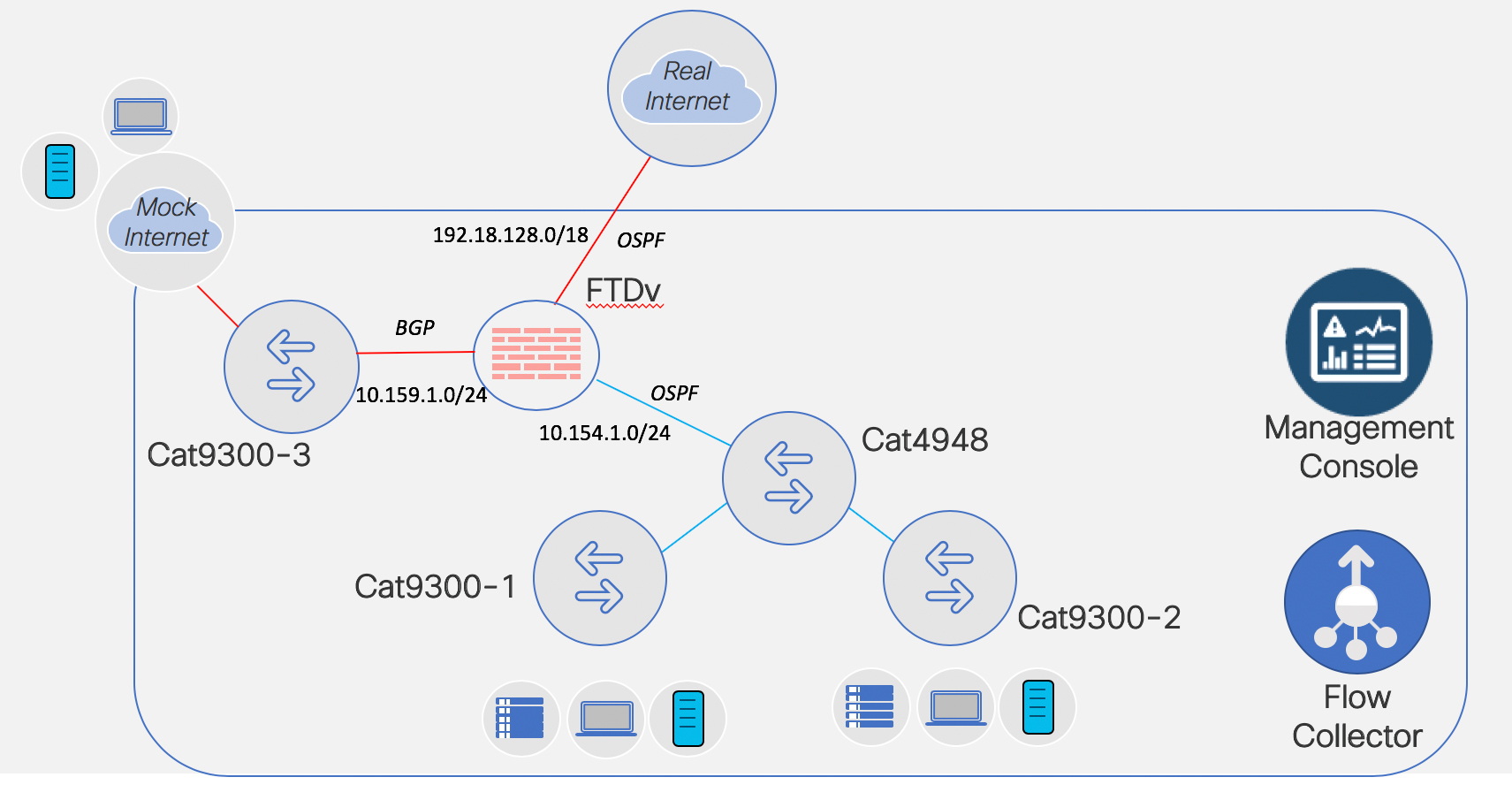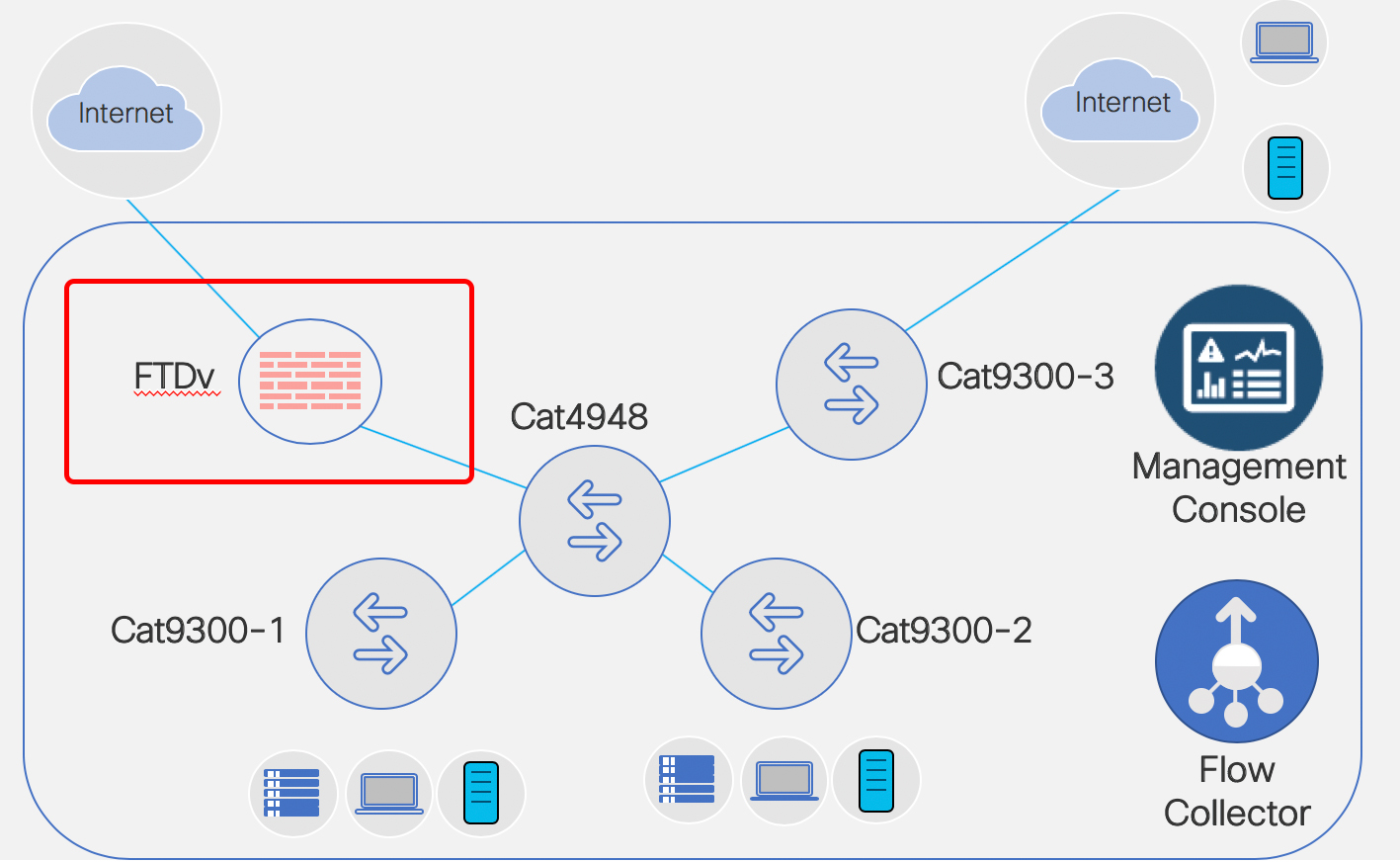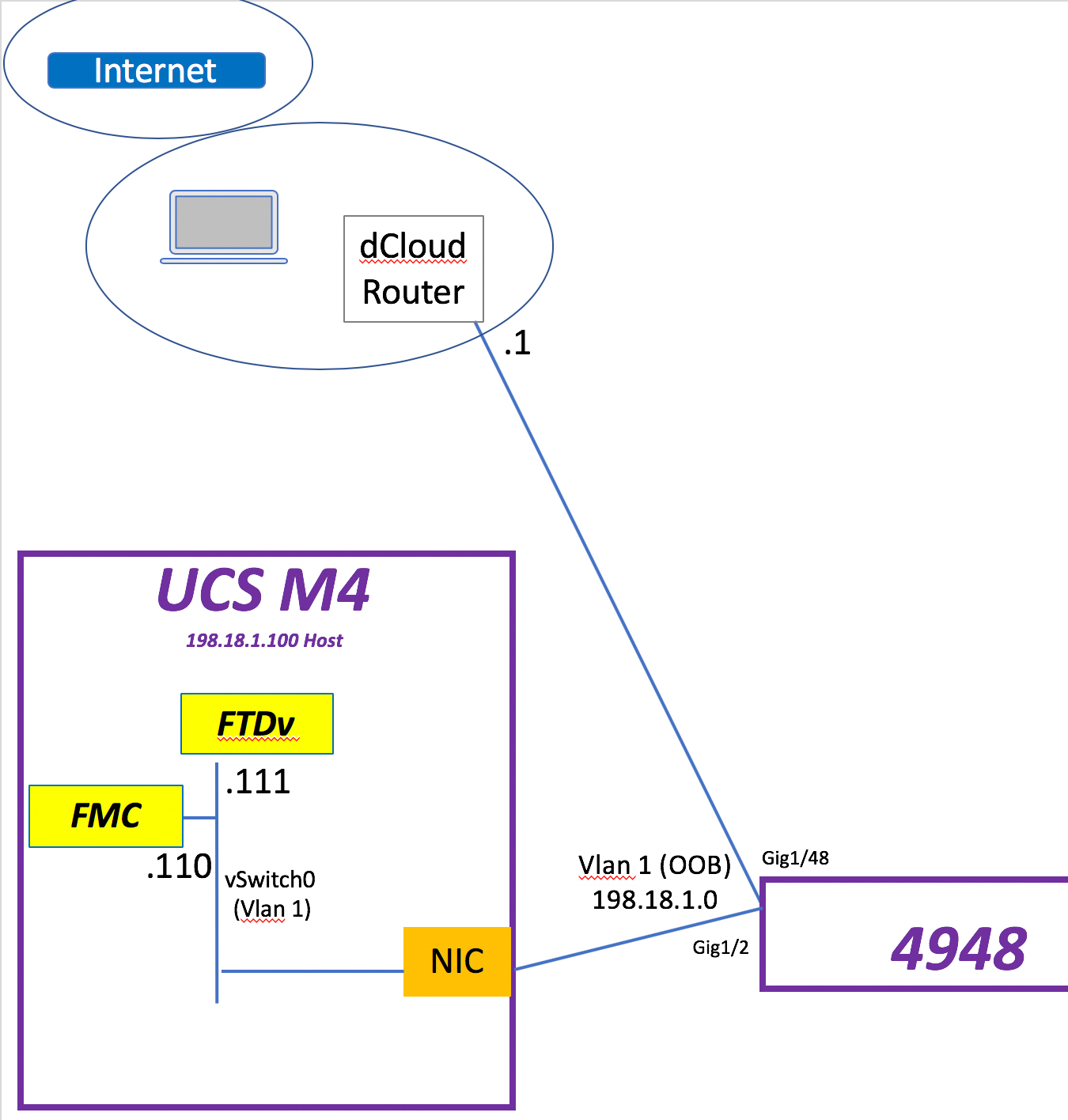Cisco Continues Kubernetes Kraze With AWS Hybrid Software
 While Cisco adds Kubernetes support across its portfolio, other vendors like VMware and IBM recently bought companies to boost their container cred.
While Cisco adds Kubernetes support across its portfolio, other vendors like VMware and IBM recently bought companies to boost their container cred.
Setting Up Addressing and Routing: FTDv Fun
In my previous blog (Fun in the Lab: FTDv & FMC – Install and Deploy) we deployed a FMC VM and a FTDv VM and ended the blog with the FTDv successfully added to the FMC.
Now? Now let’s add IP addressing for the FTDv and also set up routing protocol neighbor relationships. I learned what I am about to show you from my co-worker and friend, Keith Brister. So don’t thank me, thank Keith. 
I tossed together a ~29 minute YouTube. Obviously you can watch the entire thing. Or… here you go for the big sections.
- Overview – Start to 2:17 minutes
- Physical/Logical Mapping Overview – 2:18 to 9:25
- vSwitches, vmNICs and More in VMware – 9:26 to 16:20
- FTDv Configuring IP Adresses via FMC – 16:21 to 23:18
- FTDv Configuring IP Routing via FMC – 23:19 to 29:29
Done and Done. Easy Peasy!
Research Brief: Evolution of Security in Mobile Networks – Impact of 5G
 This new Research Brief from AvidThink delves into the evolution of the mobile network and explores new threats.
This new Research Brief from AvidThink delves into the evolution of the mobile network and explores new threats.
Related Stories
Fun in the Lab: FTDv & FMC – Install and Deploy
This is my Stealthwatch playground…. errrr… I mean … ahem… “work environment” for a Technical Solution Workshop I am working on for Stealthwatch.
Going to set up FTDv and FMC today. A co-worker and friend, Scott Barasch, helped me get jump started… so figure I’ll pass on what I just learned to you. 
What this blog will cover is
- DEPLOY
- Deploying the OVF for FTDv
- Deploying the OVF for FMC
- VMware settings
- Tweak for FTDv
- Tweak for FMC
- Prepping to Power On
- Snapshot Both Before Power On
- Power Both On
- Setup via Console
- FMC – console in and setup IP address
- FTDv – console in and step thru the prompts
- Test IP Connectivity
- Ping FMC and FTDv from the PC
- Notice Can’t ping FTDv
- Fix
- Ping
- Browse into FMC
- Change password
- Setup DNS
- Setup NTP
- Accept EULA
- Apply
- LICENSING
- License FMC
- FMC/FTDv: Make the Connection
- FTDv – Point FTDv to FMC
- FMC – bring the FTDv into the fold.

So let’s begin. What I have to host my FMC & FTDv VMs is a UCS M4 with a NIC connected to a Cat4948 in vlan 1. That NIC is tied to vSwitch0 in the UCS. Continue reading
VMware Embraces Containers at VMworld Europe
 The virtualization giant updated its hybrid cloud stack with new Kubernetes support and also announced a new integration with IBM Cloud’s managed Kubernetes service.
The virtualization giant updated its hybrid cloud stack with new Kubernetes support and also announced a new integration with IBM Cloud’s managed Kubernetes service.
Thoma Bravo Acquires Veracode From Broadcom for $950 Million
 Broadcom took over Veracode as part of its $18.9 billion purchase of CA Technologies, which it completed this week. CA bought Veracode in 2017.
Broadcom took over Veracode as part of its $18.9 billion purchase of CA Technologies, which it completed this week. CA bought Veracode in 2017.
T-Mobile, Sprint Merger Foes Raise Security Concerns Related to Huawei, ZTE
 It's no surprise that groups representing wireless workers claim the merger will cost American jobs. But connecting T-Mobile and Sprint to possible security risks related to China is a new angle that could have an impact on the deal.
It's no surprise that groups representing wireless workers claim the merger will cost American jobs. But connecting T-Mobile and Sprint to possible security risks related to China is a new angle that could have an impact on the deal.
Symantec Buys Appthority, Javelin Networks to Strengthen Endpoint Security
 The two acquisitions will boost the company's mobile and enterprise credentials, particularly with regard to Active Directory and mobile application security.
The two acquisitions will boost the company's mobile and enterprise credentials, particularly with regard to Active Directory and mobile application security.
BGP Hijacks: Two more papers consider the problem
The security of the global Default Free Zone DFZ) has been a topic of much debate and concern for the last twenty years (or more). Two recent papers have brought this issue to the surface once again—it is worth looking at what these two papers add to the mix of what is known, and what solutions might be available. The first of these—
Demchak, Chris, and Yuval Shavitt. 2018. “China’s Maxim – Leave No Access Point Unexploited: The Hidden Story of China Telecom’s BGP Hijacking.” Military Cyber Affairs 3 (1). https://doi.org/10.5038/2378-0789.3.1.1050.
—traces the impact of Chinese “state actor” effects on BGP routing in recent years. Whether these are actual attacks, or mistakes from human error for various reasons generally cannot be known, but the potential, at least, for serious damage to companies and institutions relying on the DFZ is hard to overestimate. This paper lays out the basic problem, and the works through a number of BGP hijacks in recent years, showing how they misdirected traffic in ways that could have facilitated attacks, whether by mistake or intentionally. For instance, quoting from the paper—
- Starting from February 2016 and for about 6 months, routes Continue reading
Brian Kemp is bad on cybersecurity
I'd prefer a Republican governor, but as a cybersecurity expert, I have to point out how bad Brian Kemp (candidate for Georgia governor) is on cybersecurity. When notified about vulnerabilities in election systems, his response has been to shoot the messenger rather than fix the vulnerabilities. This was the premise behind the cybercrime bill earlier this year that was ultimately vetoed by the current governor after vocal opposition from cybersecurity companies. More recently, he just announced that he's investigating the Georgia State Democratic Party for a "failed hacking attempt".According to news stories, state elections websites are full of common vulnerabilities, those documented by the OWASP Top 10, such as "direct object references" that would allow any election registration information to be read or changed, as allowing a hacker to cancel registrations of those of the other party.
Testing for such weaknesses is not a crime. Indeed, it's desirable that people can test for security weaknesses. Systems that aren't open to test are insecure. This concept is the basis for many policy initiatives at the federal level, to not only protect researchers probing for weaknesses from prosecution, but to even provide bounties encouraging them to do so. Continue reading
Fortinet Posts Solid Q3 Growth, Wins ‘Quadruple Competitor Displacement’ Deal
 Execs didn’t say which competitors Fortinet’s security products displaced, but it competes against companies including Palo Alto Networks, Check Point Software, and Cisco.
Execs didn’t say which competitors Fortinet’s security products displaced, but it competes against companies including Palo Alto Networks, Check Point Software, and Cisco.
Why no cyber 9/11 for 15 years?
This The Atlantic article asks why hasn't there been a cyber-terrorist attack for the last 15 years, or as it phrases it:National-security experts have been warning of terrorist cyberattacks for 15 years. Why hasn’t one happened yet?As a pen-tester who has broken into power grids and found 0dayss in control center systems, I thought I'd write up some comments.
Instead of asking why one hasn't happened yet, maybe we should instead ask why national-security experts keep warning about them.
One possible answer is that national-security experts are ignorant. I get the sense that "national" security experts have very little expertise in "cyber" security. That's why I include a brief resume at the top of this article, I've actually broken into a power grid and found 0days in critical power grid products (specifically, the ABB implementation of ICCP on AIX -- it's rather an obvious buffer-overflow, *cough* ASN.1 *cough*, I don't know if they ever fixed it).
Another possibility is that they are fear mongering in order to support their agenda. That's the problem with "experts", they get their expertise by being employed to achieve some goal. The ones who know most about an issue are simultaneously the Continue reading
Cisco Study Finds Enterprises Racing Toward ‘Preemptive’ IT
 Cisco developed a four-step model for IT operations maturity showing where organizations are now and where they would like to be in two years.
Cisco developed a four-step model for IT operations maturity showing where organizations are now and where they would like to be in two years.
Expanding the Possibilities With 5G
 To understand where next-gen communications will be tomorrow, look to the 5G trials of today.
To understand where next-gen communications will be tomorrow, look to the 5G trials of today.
HashiCorp $100M Series D Renders $1.9B Valuation
 The company offers open source-based software platforms that allow enterprises to manage distributed application infrastructure. It competes against companies like Puppet and Chef.
The company offers open source-based software platforms that allow enterprises to manage distributed application infrastructure. It competes against companies like Puppet and Chef.
Masscan and massive address lists
I saw this go by on my Twitter feed. I thought I'd blog on how masscan solves the same problem.If you do @nmap scanning with big exclusion lists, things are about to get a lot faster. ;)— Daniel Miller ✝ (@bonsaiviking) November 1, 2018
Both nmap and masscan are port scanners. The differences is that nmap does an intensive scan on a limited range of addresses, whereas masscan does a light scan on a massive range of addresses, including the range of 0.0.0.0 - 255.255.255.255 (all addresses). If you've got a 10-gbps link to the Internet, it can scan the entire thing in under 10 minutes, from a single desktop-class computer.
Education Service Center Region 11 Protects Student Data with VMware NSX Data Center
Rory Peacock is the Deputy Executive Director of Technology at Education Service Center Region 11, where he oversees all technology services provided to Region 11 schools.
Region 11 is one of 20 education service centers throughout the State of Texas. In Texas, an education service center manages education programs, delivers technical assistance, and provides professional development to schools within its region. With regards to technology, education service centers assist their schools with hosted services and technical support.
Education Service Center Region 11 serves 70,699 educators and almost 600,000 students across 10 urban and rural counties.
I had the opportunity to talk to Rory about some of his largest technology challenges since he joined Region 11 in 2015.
Day Zero
Region 11 is a long-time VMware customer, introducing VMware vSphere in 2009. Since then, Region 11 has virtualized over 95% of their server environment. They’ve also made the move to virtual desktops utilizing VMware Horizon to support their 200 employees.
On the very day in 2016 that a meeting was set with the VMware NSX Data Center team to demo the product, Region 11 was hit with a zero-day attack of ransomware. A legacy system was hit in its demilitarized Continue reading
Edgeworx ioFog Platform Drills Software Down to the Edge
 “Our goal is to bring a full software layer down to the lowest edge layer possible and to make building for the edge as easy as building for the cloud,” says CEO Kilton Hopkins.
“Our goal is to bring a full software layer down to the lowest edge layer possible and to make building for the edge as easy as building for the cloud,” says CEO Kilton Hopkins.
IoT Tales of Horror (Inspired by Real-Life Events)

Happy Halloween! In some parts of the world, people are celebrating this holiday of horror by dressing up as monsters or other frights and watching scary movies. But sometimes these tales can be just a little boring. Pod people? Headless horsemen? Replicant children? Whatever.
I present the real horror stories of Halloween – and every other day of the year. These tales are inspired by real-life events and are guaranteed to give you a chill. (And not just because your smart thermostat is being controlled by a shapeshifting clown who lives in the sewer!)

I(o)T
In the fall of 2018, a group of kids work together to destroy an evil malware, which infects connected toys and preys on the children of their small town.
Inspired by the terrifying vulnerabilities found in everyday connected toys.
Night of the Living Devices
There’s panic across the Internet as connected devices suddenly begin attacking critical Internet infrastructure. The film follows a group of network operators as they frantically work to protect the Internet from these packet spewing, infected devices.
Inspired by the harrowing events of the 2016 Dyn attack.
 Rosemary’s Baby Monitor
Rosemary’s Baby Monitor
A young family moves into a house billed as the “smart Continue reading



